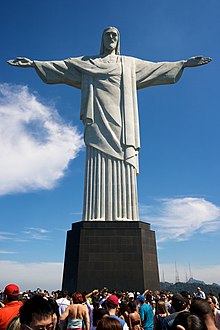Christ the Redeemer (statue)
 |
|
| Coordinates | 22°57′7″S 43°12′38″W / 22.95194°S 43.21056°WCoordinates: 22°57′7″S 43°12′38″W / 22.95194°S 43.21056°W |
|---|---|
| Location |
Corcovado mountain, Rio de Janeiro, Brazil |
| Designer | Created by French sculptor Paul Landowski and built by the engineer Heitor da Silva Costa Brazil in collaboration with the French engineer Albert Caquot. Romanian sculptor Gheorghe Leonida created the face of the statue. |
| Material | Soapstone |
| Height | 30 metres (98 ft) and 38 metres (125 ft) tall with its pedestal |
| Completion date | Dedicated October 12, 1931 |
| Opening date | |
| Restored date | |
| Consecrated October 12, 2006 New Seven Wonders of the World July 7, 2007 |
|
Christ the Redeemer (Portuguese: Cristo Redentor, standard Brazilian Portuguese: [ˈkɾistu ʁedẽˈtoʁ], local dialect: [ˈkɾiɕtŭ̻ xe̞dẽ̞ˈtoɦ]) is an Art Deco statue of Jesus Christ in Rio de Janeiro, Brazil, created by French sculptor Paul Landowski and built by the Brazilian engineer Heitor da Silva Costa, in collaboration with the French engineer Albert Caquot. Romanian sculptor Gheorghe Leonida fashioned the face. The statue is 30 metres (98 ft) tall, not including its 8-metre (26 ft) pedestal, and its arms stretch 28 metres (92 ft) wide.
The statue weighs 635 metric tons (625 long, 700 short tons), and is located at the peak of the 700-metre (2,300 ft) Corcovado mountain in the Tijuca Forest National Park overlooking the city of Rio. A symbol of Christianity across the world, the statue has also become a cultural icon of both Rio de Janeiro and Brazil, and is listed as one of the New Seven Wonders of the World. It is made of reinforced concrete and soapstone, and was constructed between 1922 and 1931.
Vincentian priest, Pedro Maria Boss, first suggested placing a Christian monument on Mount Corcovado in the mid 1850s to honor Princess Isabel, princess regent of Brazil and the daughter of Emperor Pedro II, however the project died due to lack of support. In 1889 the country became a republic, and due to the separation of church and state, the idea of the statue was dismissed.
...
Wikipedia
